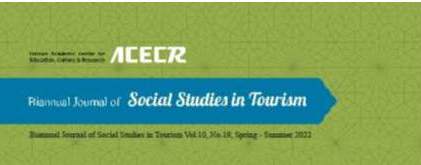-
-
List of Articles
-
Open Access Article
1 - Perceived Authenticity, Satisfaction, Revisiting, Cultural Heritage Tourism, Kourd House, Sanandaj
akbar pourfaraj sasan ahmadi -
Open Access Article
2 - Tourism, Public Policy, Tourism Policy, Policy Implementation, Gilan Province
Ezzatollah Abbasian shabnam zarjou seyyed Hamed Hashemi -
Open Access Article
3 - Investigating Agrotourism Aesthetics and Social Production of Space from Local Stakeholders’ Perspective: A Case Study of Grape Festival in Abhar City, Darsjin Village, Iran
mohamad taghi heydari Daruish jahani Ismail Dali yagoob haghi -
Open Access Article
4 - Leadership Style, Servant Leadership, Paternal Leadership, Authentic Leadership, Psychological Capital, Job Engagement, Extra-role Services
Somayeh Abedi Bagher Asgarnezhad Nouri Vali Nemati Sayed Mohammad Reza Movahed -
Open Access Article
5 - Factors affecting investment in tourism sample regions of Tehran province (Case study of sample tourism regions of Shemiranat city)
hamid Reza Zargham Broujeni Mahmood Ziaee saeid anbarestani -
Open Access Article
6 - Bibliometric Analysis, Tourism Experience, Computational Literature Review, Co-occurrence Network, Co-authorship Network
leila ilchi mesbah seivandian amir salar vanaki -
Open Access Article
7 - Freedom, authenticity, intimacy and charm: Representation of travel influencers’ photos in Instagram
hoda davari hamed bakhshi -
Open Access Article
8 - Tourism, Perceived Travel limitations, Seligman's Helplessness Theory, Disabled People
Maedeh Hashemi Zahra Nadalipour -
Open Access Article
9 - Tourism Policymaking, Local Community Support, Place Image, Tourism Impacts, Tourism in Semnan
Zohre Kiani FeizAbadi Farnaz NikKhah Elisa taherian
-
The rights to this website are owned by the Raimag Press Management System.
Copyright © 2017-2025







